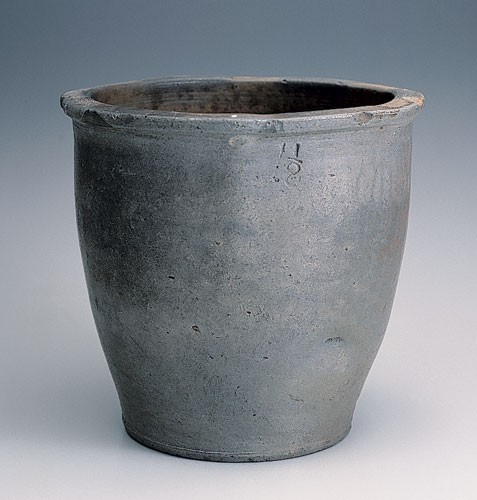
Crock, attributed to Otto Karle, Rockingham Country, Virginia, after 1868. Salt-glazed stoneware. H. 8 3/4”. (Private collection; photo, Gavin Ashworth.)

Pitcher, Joseph Silber, Rockingham County, Virginia, ca. 1868. Salt-glazed stoneware. H. 10 1/2". (Private collection; photo, Gavin Ashworth.)
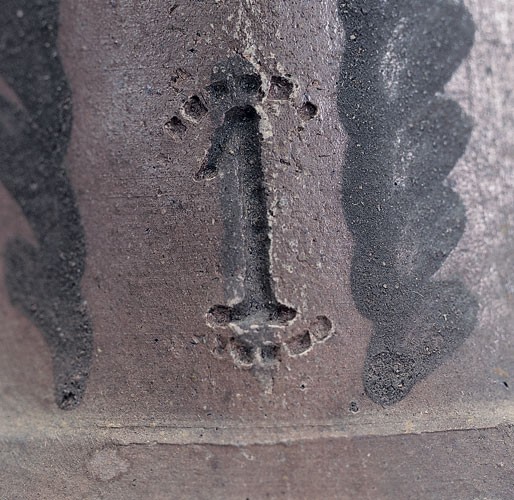
Detail of the capacity mark on the pitcher illustrated in fig. 2.
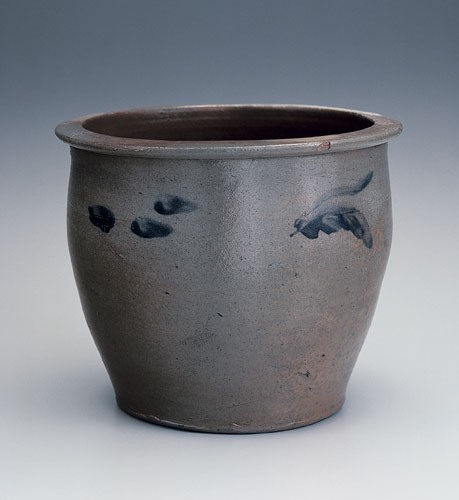
Crock, attributed to John D. Heatwole, Rockingham County, Virginia, ca. 1868. Salt-glazed stoneware. H. 7 3/8". (Private collection; photo, Gavin Ashworth.)
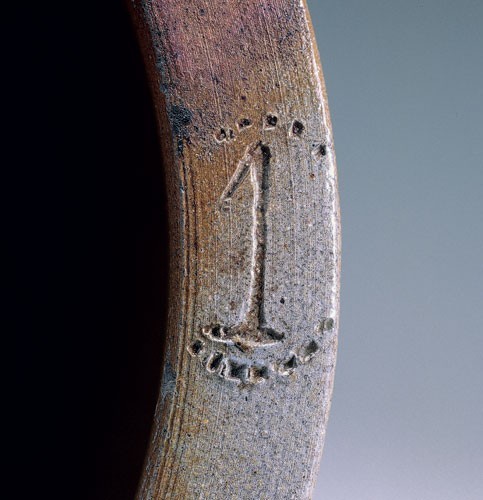
Detail of the capacity mark on the crock illustrated in fig. 4, which closely resembles that of the capacity mark on Joseph Silber’s pitcher illustrated in fig. 2.
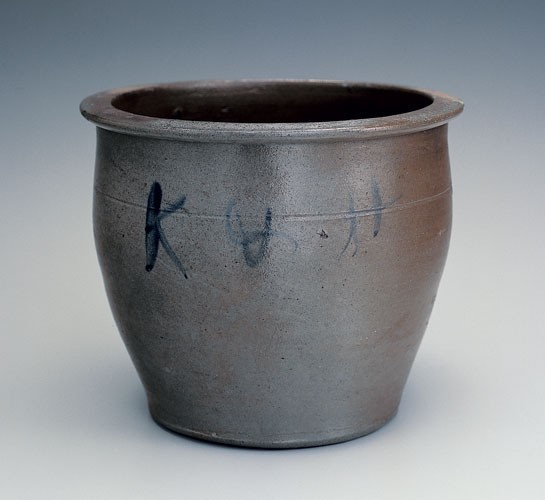
Reverse side of the crock illustrated in fig. 4. The initials “K & H” provide evidence of a link between Joseph Silber, John Heatwole, and Otto Karle of Rockingham County. (Photo, Gavin Ashworth.)
In the past several decades the wares of the nineteenth-century potters of Rockingham County in the Shenandoah Valley of Virginia have begun to garner interest, finally bringing them out of the shadow of their neighbors to the north, in Strasburg. Long ignored by scholars and collectors, fine examples of the wares of Andrew Coffman, John D. Heatwole, Emanuel Suter, and others have placed the work of this county at the forefront of traditional pottery research and collecting in the Shenandoah Valley.[1] The work of one Rockingham potter, however, has perplexed those who study this regional tradition.
The wares of Joseph Silber, a German immigrant who married a native of Rockingham County and settled there, are curiously inconsistent in form and quality. Known to have worked with both Heatwole and Suter, Silber has an impressive résumé: he was associated with Heatwole in the 1860s and later worked in Suter’s New Erection Pottery, eventually building and operating his own shop and kiln in western Rockingham County.[2] Despite these indications of skill, however, Silber’s ware often appears poorly turned, badly misshapen, and heavy—all signs of an inexperienced potter (fig. 1). Oddly, finished pieces with his mark do exist, demonstrating that his abilities were actually quite refined. The apparent discrepancy seemed unresolvable until a recent find finally provided a clue to the mystery.
In May 2000 in neighboring Hardy County, West Virginia, two pieces of decorated stoneware turned up among household goods at an estate auction in Lost City. One piece, a finely turned pitcher in a common Rockingham County form, is easily identifiable as Silber’s work by its one-gallon capacity mark (figs. 2, 3). The other, a standard one-gallon crock, also bears Silber’s mark, but its shape corresponds to known pieces by John D. Heatwole (figs. 4, 5). Moreover, along with elementary designs, the piece is initialed in cobalt “K & H,” suggesting that Heatwole did have a hand in the crafting of the pot (fig. 6). The “K,” however, stumped everyone. Numerous clues discovered over the past three years, however, point to Silber’s nephew, Otto Karle, who emigrated from Germany and lived with his aunt and uncle until their deaths. Records indicate that Karle left Baden in 1868, and in a 1915 deposition he stated that he had been in their home since he was thirteen years old.[3] Evidence from the piece itself suggests that Karle was indeed the owner of the cobalt K. Heatwole and Silber are known to have been partners in 1868, and a pot bearing that information exhibits the identical ampersand as the Lost City piece,[4] which places the pot in question within the same time frame and therefore coincides with Karle’s arrival in the Shenandoah Valley.
There is additional evidence that ties Karle closely to the Silber family and supports the supposition that when he arrived in the valley, at age thirteen, he was an unskilled worker and came to work at the pottery trade with his uncle. An 1884 summons to court lists “Otto Karl, alias Silber.” Moreover, following the death of Joseph Silber in 1890, Karle entered into an agreement with his aunt Nancy Silber to live in her home and forego collecting money owed to him, further suggesting that he had been at work in his uncle’s business.[5] The most significant aspect of these findings is that the numerous poorly made pots bearing Silber’s marks may now be more accurately attributed to Otto Karle, an unskilled teenager whose work revealed his inexperience. Although in 1915 he stated that he was then a farmer, further research will undoubtedly provide more evidence of Karle’s career as a potter, adding to the body of knowledge regarding the regional tradition of Rockingham County and Shenandoah Valley pottery and clarifying the connection between the masters and the numerous “unknown” potters of the nineteenth century.
Scott Hamilton Suter, Assistant Professor of English, Bridgewater College;ssuter@bridgewater.edu
See, e.g., Jeffrey S. Evans and Scott Hamilton Suter, “A Great Deal of Stone & Earthen Ware”: The Rockingham County, Virginia, School of Folk Pottery (Dayton, Va.: Harrisonburg-Rockingham Historical Society, 2004).
Scott Hamilton Suter, “‘The Importance of Making Progress’: The Potteries of Emanuel Suter, 1851–1897” (Ph.D. diss., George Washington University, 1994).
J.W. Silber v. Nancy E. Silber’s Heirs, Chancery Court, Rockingham County, Virginia, File 391, 1915.
See Evans and Suter, “A Great Deal of Stone & Earthen Ware,” p. 13, fig. 1.
Article of Agreement, Rockingham County, Va., Deed Book 46, 1982, p. 387.
